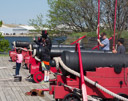
Fort McHenry
Fort McHenry coastal star-shaped fort best known for its role in the War of 1812, when it successfully defended Baltimore Harbor from an attack by the British navy in Chesapeake Bay September 13–14, 1813. It was first built in 1798 and was used continuously by U.S. armed forces through World War I and by the Coast Guard in World War II. It was designated a national park in 1925.
During the War of 1812 a storm flag (17 by 25 feet (5.2 m × 7.6 m)) was flown over Fort McHenry during the bombardment. It was replaced early on the morning of September 14, 1814 with a larger garrison flag (30 by 42 feet (9.1 m × 12.8 m)). The larger flag signaled American victory over the British in the Battle of Baltimore. The sight of the ensign inspired Francis Scott Key to write the poem "Defence of Fort M'Henry" that was later set to the tune To Anacreon in Heaven and become known as the Star Spangled Banner, the national anthem of the United States.
Fort McHenry was built on the site of the former Fort Whetstone, which had defended Baltimore from 1776 to 1797. Fort Whetstone stood on Whetstone Point peninsula, which juts into the opening of Baltimore Harbor between the Basin (today's Inner Harbor) and Northwest branch on the north side and the Middle and Ferry (now Southern) branches of the Patapsco River on the south side.
The Frenchman Jean Foncin designed the fort in 1798 and it was built between 1798 and 1800. The new fort's purpose was to improve the defenses of the increasingly important Port of Baltimore from future enemy attacks.
The new fort was constructed in the form of a five-pointed star surrounded by a dry moat — a deep, broad trench. The moat would serve as a shelter from which infantry might defend the fort from a land attack.[citation needed] In case of such an attack on this first line of defense, each point, or bastion could provide a crossfire of cannon and small arms fire.
Fort McHenry was named after early American statesman James McHenry (16 November 1753 – 3 May 1816), a Scots-Irish immigrant and surgeon-soldier. He was a delegate to the Continental Congress from Maryland and a signer of the United States Constitution. Afterwards, he was appointed United States Secretary of War (1796–1800), serving under presidents Presidents George Washington and John Adams.
During the American Civil War the area where Fort McHenry sits served as a military prison, confining both Confederate soldiers, as well as a large number of Maryland political figures who were suspected of being Confederate sympathizers. The imprisoned included newly elected Baltimore Mayor George William Brown, the city council, and the new police commissioner, George P. Kane, and members of the Maryland General Assembly along with several newspaper editors and owners. Ironically, Francis Scott Key's grandson, Francis Key Howard, was one of these political detainees. A drama beginning the famous Supreme Court case involving the night arrest in Baltimore County and imprisonment here of John Merryman and the upholding of his demand for a writ of habeas corpus for release by Chief Justice Roger B. Taney occurred at the gates between Court and Federal Marshals and the commander of Union troops occupying the Fort under orders from President Abraham Lincoln in 1861. Fort McHenry also served to train artillery at this time; this service is the origin of the Rodman guns presently located and displayed at the fort. (Adapted from wikipedia)


























